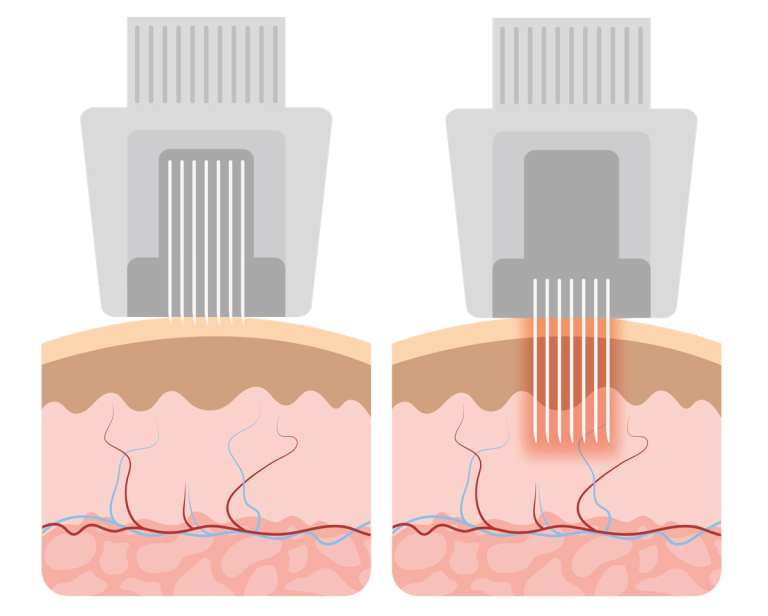Radiofrequency Microneedling At A Glance
Top Questions
Radiofrequency Microneedling Overview
Collagen is the most abundant protein in the body (making up around 30% of the body’s “dry weight”). It can be found in the skin, bones, connective tissues, joints - pretty much everywhere. It’s often referred to as the glue or the scaffolding that holds everything together structurally.
Collagen is the protein that keeps our skin looking healthy, supple, smooth and youthful. As we age, particularly as women go through perimenopause and menopause, the levels of collagen in the skin decrease dramatically. This leads to increased skin laxity, wrinkling, texture and sagginess.
Radiofrequency microneedling, also called RF microneedling, is a treatment that remodels the subdermal adipose tissues. It is one of a number of collagen inducing treatments.
It combines two collagen stimulating modalities, radiofrequency and microneedling.
There are a number of different RF microneedling devices in the UK. The two most well known devices on the market: Morpheus8 and Secret RF.
The device has a handpiece with an attachment of sterile head of dozens of “pins” - very fine needles, between 0.5 - 8mm long (Morpheus8 delivers the deepest up to 8mm), usually gold-plated, that are applied to the skin. This not only microneedles the skin, it also delivers radiofrequency via the needles.
The microneedling element creates targeted, controlled “micro” injuries to the skin which triggers the skin’s self-repair mechanism, this causes new collagen to be made.
The radiofrequency heats the deep layers of the skin and subcutaneous tissue, tightening existing collagen and, again, stimulating new collagen to be made.
The RF energy delivered deep into the skin produces faster, more dramatic results over traditional microneedling.
The result is smoother, tighter, firmer and younger looking skin.
This Glowday Treatment Guide has been verified by Vaiva Mikalauskaite
How Does RF Microneedling Work?
RF microneedling is a dual modality treatment.
A handpiece is applied to the skin. Each time the device comes into contact with the skin, the pins penetrate the subdermal tissue and a controlled dose of RF energy is delivered to the skin.
The microneedling element creates targeted, controlled “micro” injuries to the skin. This triggers the skin’s self-repair mechanism causing new collagen to be made.
The radiofrequency heats the deep layers of the skin and subcutaneous tissue to a specific temperature, tightening existing collagen and, again, stimulating new collagen to be made.

What Is Radiofrequency Microneedling Good For?
RF microneedling can be used to improve skin laxity, scarring, lines and wrinkles on the face, neck and body.
Common treatment areas include:
- Loose or sagging skin of the face, jawline, neck and body
- Wrinkles and fine lines on the face, neck and décolletage
- Under eye sagging and wrinkling
- Acne scarring
- Stretchmarks
- Pigmentation and discolouration.
Radiofrequency microneedling is appropriate for all skin tones and colours, but if you have a darker skin tone - it is very important to use an experienced and qualified practitioner.
Radiofrequency microneedling may be unsuitable in the following cases - please consult with your practitioner if you have any of the following:
- Keloid scars, history of eczema, psoriasis and other chronic conditions;
- history of actinic (solar) keratosis;
- history of Herpes Simplex infections;
- history of haemophilia;
- history of diabetes;
- the presence of raised moles, warts on the targeted area.
Absolute contraindications include;
- scleroderma, collagen vascular diseases or cardiac abnormalities;
- use of Accutane in prior 6 months;
- blood clotting problems;
- active bacterial or fungal infection;
- facial melanosis;
- malignant tumours, immunosuppression;
- use of blood thinners or prednisone;
- pregnant or nursing women;
- corticosteroids within two weeks of procedure, chronic liver disease, porphyria or other skin diseases.
Topical numbing creams are used with RF microneedling, so an allergy to lidocaine would preclude you from treatment. An undetected allergy to lidocaine or tetracaine could cause itching, shortness of breath, swelling or respiratory distress.
How Do You Prepare For RF Microneedling?
Prior to your treatment, your practitioner will advise whether you need to discontinue any particular skincare actives or medicines (under the guidance of your doctor).
Ensure you have not booked in any invasive treatments (dermabrasion, deep peels or any surgical procedure on the treatment area) within previous 3 months;
Botox, filler, fat transfer, threads, skinboosters or injectables should be avoided prior to treatment, but your clinician will guide you on appropriate timelines.
Avoid sun exposure for 4 weeks prior to treatment.
Ensure you provide your practitioner with an up-to-date and accurate medical history.
Topical numbing cream is used with microneedling and will be contra-indicated if you have a known allergy to lidocaine, tetracaine.
What Happens During A RF Microneedling Treatment?
Step One - Step One - Consultation & Consent
On arrival at the clinic, your practitioner will complete a detailed personal details and medical history form with you.
They will discuss your medical history and clearly highlight the realistic, expected result of the treatment.
Step Two - Step Two - The Treatment
Topical numbing cream and/or local anaesthetic injections numb the area to be treated.
What Should You Do After RF Microneedling?
- Avoid touching the area that was treated.
- Avoid applying any cream or makeup to the area for at least 12 hours.
- Avoid direct sun exposure until your skin feels like it’s “back to normal”.
- Follow any post-treatment advice your practitioner has given you.
What Are The Side Effects & Risks Of RF Microneedling?
Following your treatment, your skin will be red and flushed, similar in appearance to a moderate sunburn.
Your skin will also feel tight and sensitive to touch for a few days.
The redness can persist for 2-3 days following the treatment.
Mild swelling is also normal, and should resolve by itself within 2-3 days.
You may experience peeling in the areas that were treated. The skin may also feel rough/sandpaper-like for 2-7 days following the treatment. This can last 2-4 weeks.
Other potential risks include:
- Bleeding or bruising
- Infection
- Scarring
- Damage to deeper structures
- Bruising and puffiness
- Hyperpigmentation and/or hypopigmentation
- Nerve injury (very rare)
- Needle shock
- Unsatisfactory result
- Allergic reactions
- Delayed healing
How Much Does Radiofrequency Microneedling Cost?
RF microneedling costs form £600 per session.
Glowday Disclaimer
All information in our Glowday Treatment Guides and blog articles is intended for reference and information. The information given here is to help you make informed decisions when considering the wide range of non-surgical aesthetic treatments available.
It is NOT intended as medical advice. Any reliance placed by you on the information contained within the Glowday Treatment Guides, Glowday blog articles or on any of Glowday.com is done by you at your own risk.
Before undergoing any non-surgical cosmetic treatment mentioned anywhere on Glowday.com, you should fully consult with an appropriately qualified and accredited practitioner who is properly trained in and fully insured to conduct the treatment you are interested in. Neither the author of the guides or blog articles, or the practitioner who has verified the guides nor Glowery Limited can be held responsible or liable for any loss or claim arising from the use or misuse of the content of Glowday.com.

